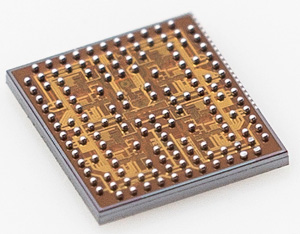- News
3 February 2016
Imec and VUB present small, low-cost and low-power chip for multi-gigabit 60GHz communication
At the 2016 IEEE International Solid-State Circuits Conference (ISSCC) in San Francisco (31 January – 4 February), nanoelectronics research center imec of Leuven, Belgium and Vrije Universiteit Brussel (VUB) have presented a four-antenna path beam-forming transceiver for 60GHz multi Gb/s communication in 28nm CMOS technology. The transceiver is claimed to be a breakthrough in developing a small, low-cost and low-power solution for multi-gigabit communication targeting WiGig as well as 60GHz wireless backhaul applications.
 Picture: The beam-forming transceiver chip.
Picture: The beam-forming transceiver chip.
Due to the tremendous growth in mobile data traffic, display and audio applications, new spectral resources in the millimeter-wave frequency bands are needed to support user demand for high data rates. One way to realize this is through mm-wave wireless networks based on small outdoor cells featuring beam-forming, a signal processing technique using phased antenna arrays for directional transmission or reception. The beam-forming steers the radiation in the desired direction while achieving a good link budget that supports high spectral efficiency.
The 60GHz transceiver architecture developed by Imec and VUB features direct conversion and analog baseband beam-forming with four antennas. The architecture is inherently simple and is not affected by image frequency interference. Moreover, a 24GHz phase-locked loop (PLL) that subharmonically locks a 60GHz quadrature oscillator is inherently immune to the pulling disturbance of the 60GHz power amplifier.
Implemented in 28nm CMOS, the 7.9mm2 prototype transceiver chip integrates a four-antenna array. The chip was validated with an IEEE 802.11ad standard wireless link of 1m. The transmitter consumes 670mW and the receiver 431mW at 0.9V power supply. The transmitter-to-receiver EVM (error vector magnitude) was better than -20dB in all the four WiGig frequency channels (58.32, 60.48, 62.64 and 64.8 GHz), with a transmitter equivalent isotropic radiated power (EIRP) of 24dBm. This allows for QPSK as well as 16QAM modulations according to the IEEE 802.11ad standard, achieving very high data rates up to 4.62Gbps.
Interested companies are invited to join imec's 60GHz R&D as a research partner and benefit from collaboration in imec's Industrial Affiliation Program, development-on-demand, academic partnerships, or access to the technology for further development through licensing programs.
Imec and Vrije Universiteit Brussel report first 79GHz radar transmitter in 28nm CMOS


